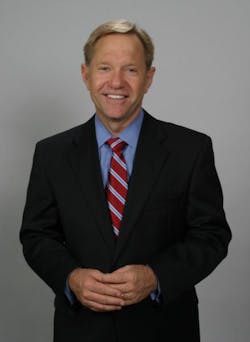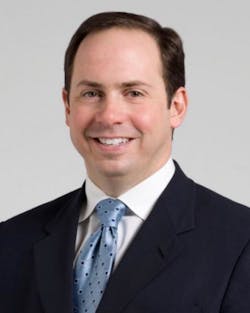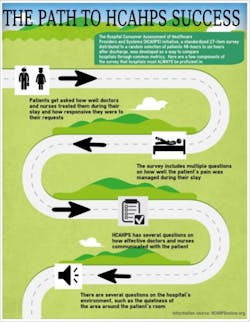Hospital Leaders Create ‘The Culture of Always’ (INFOGRAPH)
Whether it’s through better communication or simple amenities, even the most optimistic leader at a hospital will tell you there is no perfect path to perfect patient satisfaction.
However, thanks to the Centers for Medicare & Medicaid Services’ (CMS) mandatory Value-Based Purchasing (VBP) program, the Hospital Consumer Assessment of Healthcare Providers and Systems (HCAHPS) initiative, hospitals across the country are certainly going to try to achieve that formula.
Of course, hospitals have been trying to achieve perfect patient satisfaction well before the term HCAHPS was brought into existence. As Rhonda Scott, R.N., Ph.D., and chief nursing officer (CNO) at the Atlanta-based, 953-bed Grady Memorial Hospital, says: “Patient satisfaction isn’t new. What’s new is the HCAHPS component from the government as a way to compare apples-to-apples.”
HCAHPS, a standardized 27-item survey distributed to a random selection of patients 48-hours to six weeks after discharge, was developed as a way to compare hospitals through common metrics. It is tied to reimbursement from the VBP program, accounting for 30 percent of a hospital’s total performance score (TPS) for FY 2013. Overall, eight measures are factored into the patient satisfaction part of the TPS: communication with nurses and doctors (separately), staff responsiveness, pain management, communication about medicine, discharge, cleanliness and quietness, and overall rating.
(SEE INFOGRAPH BELOW)
‘CULTURE OF ALWAYS’
Quint Studer, founder of the Gulf Breeze, Fla.-based Studer Group, a consultancy which partners with healthcare organizations to help them improve HCAHPS scores, says organizations that do best on it put it in the clinical quality realm. Furthermore, he says, they’re consistent.
Quint Studer
“Healthcare has always been challenged by consistency,” Studer says. “Not only does HCAHPS measure whether you are doing it period, it measures whether or not you are doing it consistently. In the past, other surveys would ask, ‘Was your pain managed?’ Today, it says, ‘Was it managed always, often, sometimes, or never?’ All of sudden organizations that may have looked pretty good on a patient satisfaction survey don’t look good on an HCAHPS feedback because of that missing consistency.”
As Scott says, “HCAHPS is a culture of always.” And that culture is not longer just applicable to Medicare reimbursement, says Katie Owens, practice leader at the Pensacola, Fla.-based consultancy firm, Baptist Leadership Group. Owens says she has started to see commercial payers beginning to follow suit through accountability in relation to HCAHPS scores.
NURSE COMMUNICATION
Hospitals like Grady have poured millions of dollars into improving patient satisfaction—and ultimately, HCAHPS scores—through various initiatives, as the first payment adjustments take effect this year from previous evaluations. While Grady didn’t do as well as it would have liked the first time around, Scott says she hopes it will be more than a little better the next time.
One area of focus, for Grady Memorial and others is nursing communication. The hospital has invested in mobile phones for nurses from Amcom (Eden Prairie, Minn.). According to Scott, through this system, patients can hit a button and it sends a direct text message to their nurse with a specific request. The patient can also call that nurse, and if he or she doesn’t answer, the call will be sent to a different nurse. In the months since these phones have been implemented, Grady’s nurse communication scores have skyrocketed to the 96th percentile.
Other hospitals, such as Lafayette General Medical Center, a 353-bed acute-care facility in Lafayette, La., have similarly focused on nursing communication. According to Lafayette’s president and CEO, David Callecod, the hospital has implemented daily active nurse rounding on every unit. At Cleveland Clinic, a non-profit academic medical center in Cleveland, Ohio, James Merlino, who is chief experience officer and head of all patient experience-related initiatives, says hourly rounding from nurses has driven improvement in this area.
James Merlino
Why is there such emphasis on nurses? According to Scott, it goes back to consistency. “First of all, if a patient is in the hospital, it’s because they need round-the-clock nursing care. If it can be done in an outpatient center or a physician’s office, it would be done. Nurses are probably the only constant caregiver with the patient,” she notes.
IMPROVING THROUGH IT
Grady’s nursing mobile initiative isn’t the only example where hospitals have invested in health IT to improve the patient experience. According to Scott, Grady itself also has also invested in upgrading its Epic Systems Corporation (Verona, Wis.) electronic medical record (EMR) and implemented a barcode scanning system for medication administration. At Lafayette, Callecod says the hospital has upgraded its EMR from the Cerner Corporation (Kansas City, Mo.) and joined a health information exchange.
Cleveland Clinic’s Merlino is a firm advocate of health information systems in improving the patient experience. He says by collecting data on patients and merging it with healthcare IT data, the hospital can better understand how different populations of patients react to their experience and then use it to improve processes.
“We’re able to do deep dives on extensive demographics to understand how patients rate their experience,” Merlino says. “For instance, we know that sicker patients at hospitals have lower satisfaction. When you drill down on that data, you realize they rank their experience that way because they require more robust communication. And so we can focus on improving communication to challenged populations, because we know that will improve their compliance, help them better understand their treatment, and reduce medication errors. Linking IT through the data that has been collected has been revolutionary for us.”
NOISE AND MORE
Across the landscape, hospitals have drummed up both obvious and unique ways to improve patient satisfaction scores and the overall experience. At Grady, Scott says part of their $4 million renovation has included more channels on the TV, better food options, and more private, high-tech friendly rooms. Changing the flow of the operating room, allowing for a more streamlined process for patients, is an ongoing project at Lafayette General.
Noise is the big thing at Phoenix’s Children Hospital, a 345-bed facility, where Deb Green, R.N., nurse manager for the cardiovascular intensive care unit, has led the implementation of a number of strategies to reduce noise in the ICU. This includes standard steps such as constructing noise-reducing walls and floors and more high-tech measures such as working with Vocera (San Jose, Calif.) and Philips Healthcare (Andover, Mass.) to reduce the noise monitors make by having a nurse’s handheld deviecs ring instead.
“Noise is something you don’t even think about often as a part of healing,” Green says. “You can’t get a calm body system if the noise level is so high it’s causing your heart rate to be elevated and your blood pressure to change.”
THE RIGHT THING
The HCAHPS initiative and the government’s “culture of always” are far from perfect in the eyes of many. For one, as Scott says, what the patient wants 100 percent of the time might not always result in the best outcome. She says the use of morphine to manage pain is an example where this could come into play. She also notes how unlike a vacation or a restaurant, going to a hospital is not something patients plan on doing.
However despite some possible hesitation about HCAHPS, Scott and others, are adamant that focusing on the patient experience is the right thing to do, not because of the incentive money tied to it, but because “it should be a part of what you do.” At Cleveland Clinic, it’s become such an intricate part of the culture, they took the entire workforce (43,000 in all) offline, sat them at tables of eight-to-10, and had them discuss how to best deliver the hospital’s “patients first” initiative.
“There are incredible opportunities to improve and change the way we deliver medicine. Don’t view this as a mandate, and don’t view it as something that’s being forced upon you. View it as something that’s right for patients and use the opportunity to improve the way we deliver care,” concludes Merlino.





